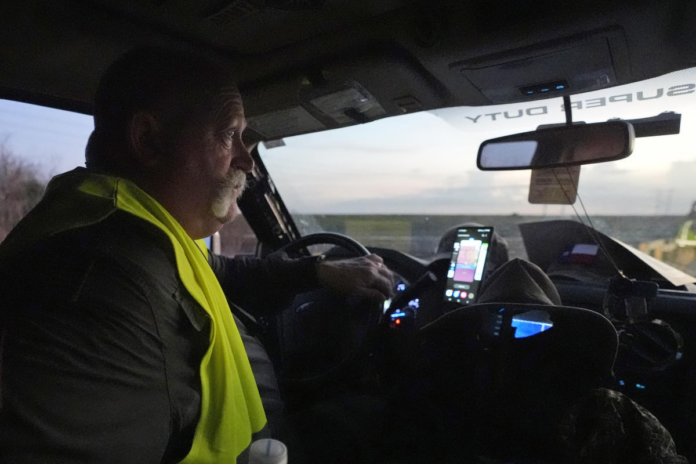Thomas Aycock, a contractor with the Florida Fish and Wildlife Conservation Commission, drives along a levy searching for invasive Burmese pythons, Tuesday, Aug. 13, 2024, in the Florida Everglades. (AP Photo/Wilfredo Lee)
HOLEY LAND WILDLIFE MANAGEMENT AREA, Fla. (AP) — It’s after midnight when the windshield fogs up on Thomas Aycock’s F-250 pickup truck. He flashes a low smile as he slowly maneuvers through the sawgrass, down dirt roads deep in the Florida Everglades.
His windshield just confirmed it: When the dew point drops in the dead of the night, it’s prime time for pythons.
“I catch more pythons when that happens,” Aycock explained. “It’ll make things start moving.”
Aycock, a contractor with the Florida Fish and Wildlife Conservation Commission, has hunted Burmese pythons in the Everglades for 11 years. The retired U.S. Army veteran divides his time between North Carolina, the Florida Panhandle and Homestead, Florida, where he keeps a recreational vehicle.
He always participates in the Florida Python Challenge, hosted by the wildlife commission to incentivize people to track down invasive Burmese pythons that thrive in Florida’s preserved wetlands. This year’s 10-day challenge ends at 5 p.m. Sunday.
The timing is intentional: Pythons typically hatch from their small, leathery eggs each August before wriggling away into the swamp.
Aycok loves snakes. He’s also passionate about preserving the Everglades and understands the “greater ecological issue with these pythons,” a prolific apex predator threatening Florida’s native snakes and mammals.
These pythons are notoriously hard to spot in the wild and determining their numbers is difficult, but the United States Geological Survey conservatively estimates tens of thousands have spread from South Florida. With each female laying clutches of 29-50 eggs on average, their impact has been devastating.
In one 2012 study, the USGS found populations of raccoons had declined by 99.3%, opossums by 98.9% and bobcats by 87.5% since the early 2000s. Controlling this voracious snake species, scientists say, is a critical goal.
More than 600 hunters participated in this year’s challenge, hoping to top last year’s total of 209 pythons killed. The grand prize winner, who humanely kills the most, receives $10,000.
The competition is designed to raise awareness and has succeeded on that score, attracting celebrities and inspiring reality television shows.
But the need for python control is so much bigger. Since 2017, Florida has been paying some 100 contractors to round them up year-round in a project shared by the wildlife agency and the South Florida Water Management District.
Through 2023, more than 18,000 pythons have been removed from the wild, with about 11,000 taken out by contractors like Aycock.
It’s a decent supplemental income — $13 an hour while driving the backroads, or $18 an hour if they walk into the swamp — and contractors also get paid per snake: $50 for the first 4 feet (1.2 meters) in length, plus $25 per subsequent foot.
“You’re not going to make a living doing this full-time. There’s no way you could do it,





